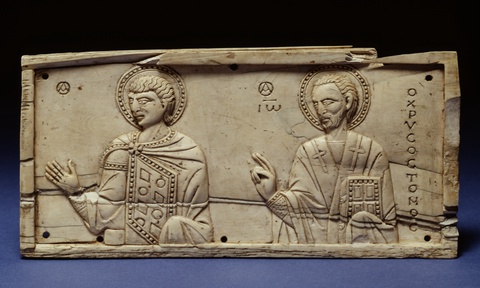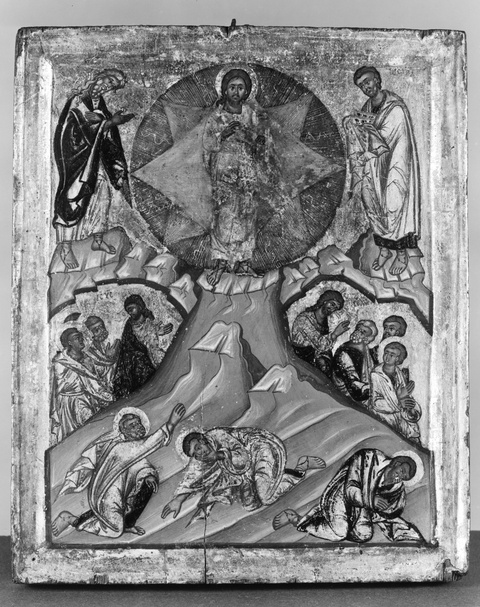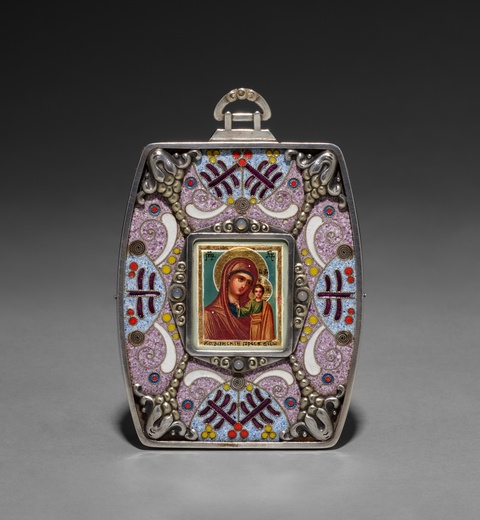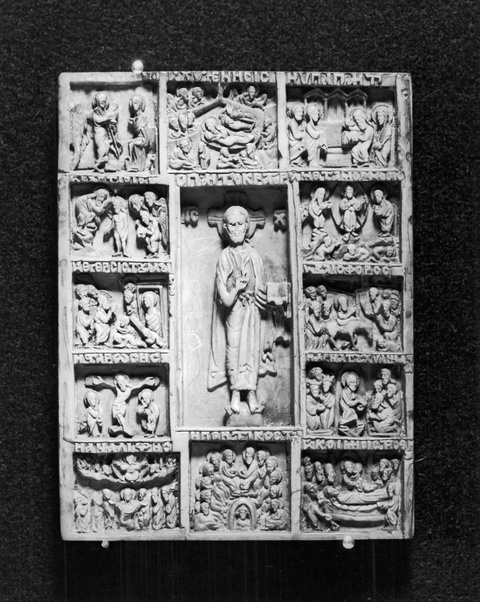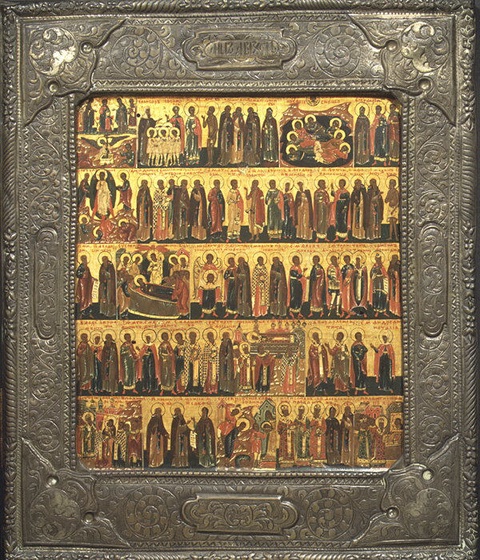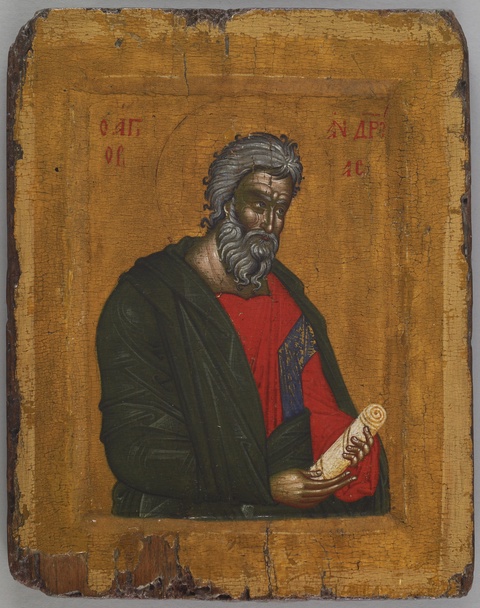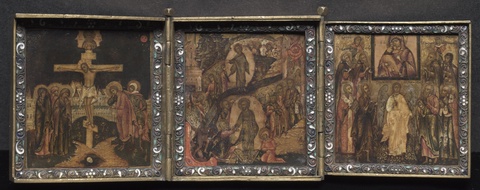The Power of Icons: Shaping Orthodox Christian Identities
By Nebojša Ratković•August 2023•9 Minute Read
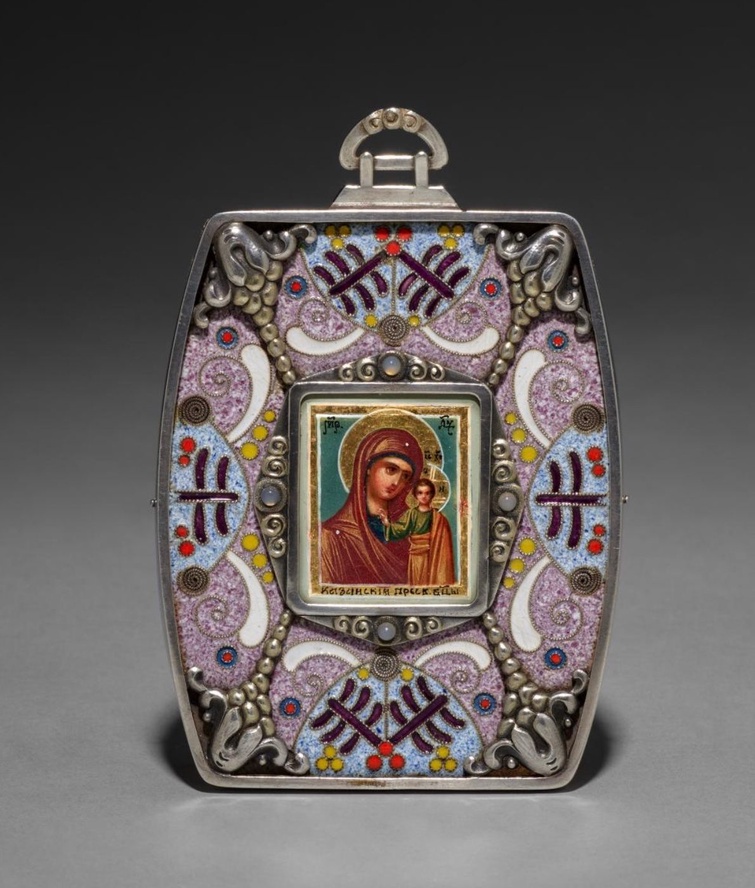
House of Fabergé, Pendant Icon of Our Lady of Kazan, 1915. Silver, enamel, and glass. Cleveland Museum of Art, CC0. The icon represents the Virgin Mary as the patroness of the city of Kazan and the Holy Protectress of Russia.
Icons shape identities among the Eastern Orthodox people in many ways. Despite challenges and controversies, they remain integral to the tradition.
Historical Background
Orthodox icons are typically made using older traditional methods and materials, by skilled iconographers who follow specific guidelines and techniques. The icons often depict religious figures, such as Jesus Christ, the Virgin Mary, saints, and angels in a stylized manner, with symbolic elements and rich colors. Orthodox icons can be found in various contexts, including churches, homes, and religious ceremonies. They are considered sacred and are used for worship, meditation, and as aids for spiritual contemplation.
The use of icons can be traced back to early Christian communities. The veneration of icons became more prominent in the Byzantine Empire, particularly during the 8th and 9th centuries CE, where iconography developed as a means to convey religious teachings. The form became tightly intertwined with Orthodox worship. Icons represented a connection between the earthly and the divine.
The Earthly and the Divine
The Iconoclastic Controversy during the 8th and 9th centuries further emphasized the power of icons. Iconoclasm, in the context of the Eastern Orthodox Church, refers to a historical period marked by the opposition to the veneration of icons. Iconoclasm literally means "image-breaking" and refers to the deliberate destruction or removal of icons from churches and other religious spaces. Iconoclasts believed that the use of icons in worship violated God’s commandment against graven images. This led to a period of intense debate during the period of the Byzantine Empire within the Eastern Orthodox Church. Eventually, the iconoclastic movement was condemned as heretical by the Seventh Ecumenical Council, also known as the Second Council of Nicaea, in 787 CE, and the veneration of icons was reaffirmed as an integral part of Orthodox Christian tradition. The Orthodox Church vehemently defended the use of icons, asserting that they were not idols but rather windows to the divine.
In this example we can see the connection between the mundane and the sacred. This icon represents St. John Chrysostom and another man whose clothes, especially his tunic clasped at the shoulder, suggest that he was an early martyr. In the Orthodox Church, martyrs hold great significance. They are individuals who have willingly sacrificed their lives for their faith. Martyrdom is seen as the ultimate act of devotion to God. The Orthodox Church venerates martyrs as examples of faith, courage, and steadfastness. The stories of their lives serve as inspiration for believers and are commemorated in liturgical services and icons.
Icons depict religious figures, such as Jesus Christ, the Virgin Mary, and saints, who are believed to have a direct connection to the sacred. By gazing upon these icons, believers can establish a spiritual connection with these holy beings. In addition, icons are created using specific techniques and materials that are believed to be infused with spiritual significance. The use of gold leaf, vibrant colors, and intricate details in iconography aims to convey divine radiance and transcendence. Icons have a role in various religious practices, such as prayer, veneration, and processions. They are often kissed, touched, or adorned with candles and incense. Through these practices, believers seek to experience a tangible connection with the spiritual realm.
Theological Significance
The theological significance of icons cannot be overstated. Orthodox theology holds that icons are not mere artistic representations but rather windows into heaven. The veneration of icons is rooted in the belief that the spiritual presence of the depicted figures, such as Christ, the Virgin Mary, and the saints, is made manifest through their icons; these channels of divine grace and presence enable believers to commune with the holy figures they depict.
Icons become visual anchors for the Orthodox worldview, shaping individuals' understanding of their faith and their place within the community. For example, the evidence of the theological significance of icons is visible in the abrasion of Christ's image in the following work.
The physical form of the icon bears the evidence of the venerating touch and kiss of the faithful. Eastern Orthodox monks placed a special value on the Transfiguration because they believed that, like the apostles shown in the bottom of this panel, they too could see God's light through contemplation. By gazing upon an icon, Orthodox individuals seek spiritual transformation and seek to emulate the virtues embodied by the holy figures represented.
Furthering the Faith
Unknown Artist, Feeding the Multitude, 6th century CE. Bibliothèque Nationale de France, public domain.
Icons also serve as catechetical tools, teaching theological tenets to the literate and illiterate alike by using visuals rather than text. The iconographic tradition preserves and communicates essential aspects of Orthodox theology, such as the Incarnation, the role of the saints, and the liturgical life of the Church. Orthodox icons can serve both narrative and symbolic purposes.
Unknown Artist, Jesus Among the Doctors, 1263–1280 CE. Mosaic. Hagia Sophia, public domain.
While some icons depict specific scenes from the lives of saints or events from the Bible, others focus on individual portraits of saints or Christ. These portraits often include specific symbols and attributes that represent the identity and significance of the depicted figure. These symbols can anchor narratives and convey theological or spiritual messages. However, it is important to note that icons are not meant to be comprehensive visual narratives in themselves. They are intended to be aids for contemplation and worship, complementing the oral tradition, scripture, and teachings of the Church.
Sociocultural Context
This theological power extends to the cultural and social lives of Orthodox communities. Icons connect individuals to a shared tradition that spans centuries, and continues to be present in every aspect of Orthodox life, from personal prayer corners in homes to the grandest churches. The presence of icons in these spaces serves as a constant reminder of Orthodox beliefs and practices, reinforcing a sense of belonging and commitment to the faith.
Fred Romero, Neimar - Krušedolska, 2018. Photograph. Wikimedia commons, CC BY 2.0. This photo depicts the interior of a church in Belgrade dedicated to Saint Sava, the founder of the Serbian Orthodox Church.
Icons also play a direct role in Orthodox liturgy and rituals. They are prominently displayed in churches, serving as focal points for worship. Most Orthodox churches include depictions of Jesus Christ, the Virgin Mary, and major saints such as St. Nicholas, St. George, and St. John the Baptist. These icons often follow established iconographic conventions and are recognized across different Orthodox communities. However, there are also icons that are more specific to certain regions or local traditions within Orthodoxy. For example, there may be icons depicting local saints or events that hold particular significance to a specific Orthodox community. Additionally, different Orthodox churches may have their own unique iconographic styles or preferences in terms of artistic techniques, colors, and symbolism.
Strengthening Communal Bonds
The veneration of icons is not only an individual act of devotion but also a communal practice that unites believers in their shared faith. The practice of venerating icons during liturgical services in testimonial acts, such as kissing or bowing before them, deepens the communal experience through a sense of shared reverence. This communal act reinforces the bonds of the Orthodox community and strengthens the spiritual connection among its members.
This pendant icon of Our Lady of Kazan represents how the veneration of icons extends beyond church walls, permeating everyday life. Orthodox individuals often wear small icons around their necks or carry them in their wallets as sources of protection and guidance. The small, portable Icons are also present during important life events, such as weddings, baptisms, and funerals, acting as witnesses to these sacred moments and connecting them to the larger story of salvation.
The art and craftsmanship of creating these icons also has a role in shaping Orthodox identities. Iconographers undergo rigorous training and adhere to specific artistic techniques and conventions. The process of creating an icon involves prayer, meditation, and attention to detail.
This carved relief shows how complex an icon’s artistry can be. The central figure of Christ is surrounded by twelve scenes representing the major feasts of the Orthodox Church.
We can also find examples of how icons shape identities through the intergenerational transmission of faith, such as by illustrating the religious calendar that represents saints and annual festivals.
Children grow up surrounded by these visual representations of the sacred. Through their exposure to icons from an early age, they internalize the beliefs and practices of the Orthodox Church, linking them to previous generations and shaping their future roles within the faith community.
Individual Perspectives
Many Orthodox individuals develop personal relationships with specific icons, forming emotional connections and finding solace, inspiration, and guidance through them. Icons become companions in prayer, sources of comfort in times of distress, and reminders of the presence of the divine in their lives. An example can be found in the triptych icon, which we can assume was used for private prayer and meditation. The main feature of these icons is that they can be folded and closed when not in use.
Challenges in Modern Times
The history of icons has not been without challenges. The Iconoclastic Controversy, for example, forced the Church to articulate and defend its position on the use of icons, leading to a deeper theological reflection on the nature of images, representation, and the incarnation of Christ. The Iconophiles argued that icons were not objects of worship but rather windows to the divine. They emphasized the importance of the incarnation, asserting that since God became human in the person of Jesus Christ, it was permissible to depict Him and other holy figures in visual form.
These debates also led to the development of specific guidelines for iconography, ensuring that icons accurately conveyed the theological and spiritual truths of the faith. Iconographers were tasked with following established canons to create icons that were faithful to Orthodox theology.
In modern times, the use of icons continues to raise questions. Some critics argue that the veneration of icons can lead to superstition or distract from a deeper understanding of the faith. Additionally, the rise of secularism and the influence of other religious traditions have posed challenges to the traditional Orthodox understanding of icons. This reexamination prompts Orthodox believers to reflect on the role of icons in their identities and navigate the tension between tradition and modernity.
But despite misunderstandings and tensions, and sometimes because of them, Orthodox icons remain integral to the continuation of church life and tradition. These windows to the divine reflect the enduring belief in the power and significance of icons within the Orthodox faith.
Nebojša Ratković is a 2023 Curationist Fellow. He holds an MA degree in International economics (Graduate school of international economy in Belgrade, Serbia) and MA in International humanitarian action (Deusto University in Bilbao, Spain and University College Dublin, Ireland). Nebojša has been working in the non-governmental sector since 2010, mostly on projects related to education and culture. He has been Education Program Manager at Wikimedia Serbia since September 2016 where he works on promoting new technologies in schools, universities and cultural institutions, with a focus on Wikipedia, Wikimedia Commons and Wikidata. He conducted more than 350 workshops for different groups. He also works as a psychotherapist and counselor.
